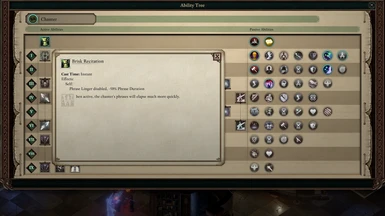
Here's a Wwise example of what one of these sounds would look like. While distinction is great to go for, subtlety can be a great attribute that can lead to more effect feedback, when picking up gameplay objects.Īll objects have a sound for picking it up/dragging it in the inventory (3 variations) and consuming it (1 variation, if applicable). It makes the sound more distinct, but also made the sound pretty annoying when a card was picked up multiple times.
#Pillars of eternity mods voice full#
Instead of just picking up a card for half a second, We'd slowly pick it up for a full second while kind of wrinkling it. On a lot of sounds, we made the variation takes play out too long. Getting to that point took a long time, though. Picking an item up slowly and giving it a distinct "rhythm" allows the sound to be both satisfying and to-the-point. A card never sounds the same when being picked up multiple times, and the kind of feedback it gives to the player can depend on how it's picked up. Something that was great that we learned along the way was how creative you can be with simply making sounds for a very small item, like a card. Overall, we succeeded in getting all objects in the game to have unique and distinct inventory sounds. Here's an overall video of picking up various items in the test level. Here are pictures from the recording studio foley session:Īll of these items allowed for a huge variety of sounds for inventory SFX in The Outer Worlds. Here are pictures of the foley room, where various props were used and brought into the recording studio.

The transient points show a good estimate of how many variations were recorded:

So for example, we'd have 2 different pieces of cloth for "Armor Medium" and record each one by making various takes of grabbing/moving/wrinkling, with the guidelines above in mind. We recorded each object based on each sub-category. Succinct to prevent unnecessary feedback. They had to be no more than a second long.ī. We also tried to incorporate some sort of memorable "rhythm" to each sound. Every sound needed to give very clear feedback.ī. Picking them up as a player would naturally, with slow-ish speed and not too quickly.Ī. Transients had to be soft and subtle, not hard and sharp.ī. Here are some guidelines we followed for achieving this goal when recording and designing each sound:Ī. We took pictures of each individual item and printed them out to take to the studio for reference, to make sure that what we recorded would match the visual. We made a test level so that we could test every single unique pickup in the game.Įvery prop we used for each sound had to match the texture and quality of the object. We recorded and designed for 9 parent categories for items, with a total of 48 sub-categories of items. If you pick up a can, we want the player to hear a can. Our overall sound design philosophy for inventory items was to have them represent their respective objects as close as possible. The level of detail we went for allowed the world to come alive even more through the many objects that the player will come across. These are items that become important for the player's journey, and it's important that we made each item sound as unique as they looked.

The goal for inventory items was to immerse the player into the Halcyon colony to really feel like they are the unplanned variable, picking up and using all sorts of items in the various worlds that they travel to. What did we consider Inventory in The Outer Worlds? "Inventory items", were game objects that the player could pick up during gameplay, consume, or drag/drop anywhere in/out of the inventory screen. In Part 2, we’re going to look at some other areas: Weapons, Inventory and some of our Scripted Events, so strap in and enjoy! Inventory Design

In Part 1, we covered how we designed Creatures, the Music system, VO, Emitters, Ambience and Spatialization in the game. Welcome back to Part 2 of our deep dive into the Sound of the Outer Worlds!


 0 kommentar(er)
0 kommentar(er)
